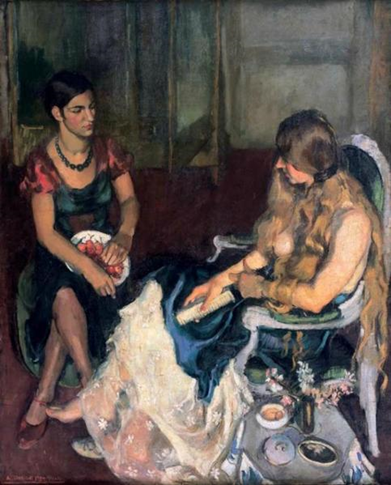Artist to Know: Amrita Sher-Gil
Considered one of India’s preeminent Modern artists, Amrita Sher-Gil frequently explored the daily lives of Indian women of her time. She depicted women as subjects and objects, often capturing their sense of despair, hopelessness, and loneliness. Her style, propelled by South Asian Modernism, later inspired the formation of the Bombay Progressive Artists’ Group. Sher-Gil’s paintings took inspiration from European Modernism and her everyday life in India. Her work, hardly acknowledged during her lifetime, is now considered among the most expansive by any Indian artist.

Recently, Sher-Gil’s 1938 oil painting In the Ladies Enclosure fetched USD 5,140,000 at auction. It became the second-most expensive Indian artwork ever sold and the highest-grossing artwork by the artist. Saffronart offered the piece with an estimate of $4,081,635 to $5,442,180 during the auction house’s Summer Live Auction. Rendered in earthy reds and browns, the painting features a group of women and a girl performing daily chores. Following this record-breaking result, Auction Daily explores Sher-Gil’s life and legacy.

An Artistic Childhood
Amrita Sher-Gil was born on January 30th, 1913, in Budapest as Dalma-Amrita. Her father, Umrao Singh Sher-Gil Majithia, was a Sikh nobleman and a Persian and Sanskrit scholar. Her mother, Marie Antoinette Gottesmann, was a Hungarian-born singer. When Sher-Gil was eight years old, her family moved to India and settled in the northern Indian hill station, Shimla. Here, Sher-Gil began taking formal art lessons.
In 1924, Marie Antoinette took the artist to Florence. However, Sher-Gil disapproved of living in Italy, and within six months, she returned to Shimla. At 11 years old, Sher-Gil won her first prize for painting. She started taking art lessons with British artists Hal Bevan Petman and Major Whitmarsh. Soon, she started using live models for her paintings.
Life in Paris
At 16 years old, Sher-Gil moved to Paris with her family and continued studying art under the mentorship of Pierre Valliant at the Académie de la Grande Chaumière. She then studied at the École des Beaux-Arts until 1933. While there, she studied the works of European masters, particularly Amedeo Modigliani, Paul Cézanne, and Paul Gauguin. Her work during that time included themes like life in Paris, self-portraits in various moods, still lifes, and portraits of lovers, relatives, and friends.

In 1932, at 19 years old, Sher-Gil painted her first critically acclaimed work, Young Girls. It won her a gold medal at the Paris Grand Salon in 1933. She became the only Asian ever to receive this distinction. The painting features her younger sister, Indira, sitting in a poised posture across from an awkwardly seated French friend, Denyse Proutaux. Indira wears Western clothing, and Denyse is partially undressed. The painting now resides at the National Gallery of Modern Art, New Delhi.
Final Years in India
Despite her early success in Paris, Sher-Gil increasingly longed for her country. “I began to be haunted by an intense longing to return to India, feeling in some strange inexplicable way that there lay my destiny as a painter,” she wrote. In 1934, Sher-Gil returned to India and declared, “Europe belongs to Picasso, Matisse, Braque and many others. India belongs only to me.” A year later, she began working as an assistant editor and writer at The Statesman. She met art collector Karl Khandalvala, who helped Sher-Gil discover a passion for traditional Indian art. She introduced Indian folk styles in her paintings and also derived influence from the frescoes of Ajanta, Ellora, and Mattancheri.

While living in her father’s ancestral home, Sher-Gil painted Three Girls. The exhausted girls in the painting reflect the artist’s melancholy. As if headed for the same destiny, they gaze in the same direction. Sher-Gil presented Three Girls at the 46th Bombay Art Society Annual Exhibition in 1937. The work bagged the gold medal.
In 1938, Sher-Gil went back to Hungary to marry her cousin, Dr. Victor Egan. The couple settled in Saraya, a village in Gorakhpur, Uttar Pradesh. Her work from this time depicted rural life and village scenes. In the Ladies Enclosure and Siesta are two examples featuring Sher-Gil’s intimate portrayal of domestic and everyday scenes.
Sher-Gil experienced severe depression after returning to India. The country was under British rule and was suffering from poverty, famines, and the destruction of Indian culture. Her depression became so severe that the couple decided to relocate to Lahore, now part of Pakistan. Soon after, she died of a sudden illness on December 5th, 1941, days before her first solo show in Lahore.
Her Legacy
At 28 years old, Amrita Sher-Gil left behind a legacy as one of the foremost artists of the 20th century. Her style has left an everlasting impact on Indian art. Her extraordinary portrayal of ordinary women earned her the nickname ‘India’s Frida Kahlo.’ In her short career, Sher-Gil created a seminal body of work representing the diversity and range of her interests.

To date, 172 paintings by Sher-Gil have been documented. Most of them are part of the National Gallery of Modern Art, New Delhi. Her work remains an integral part of Indian art and tradition. The Government of India has declared her paintings are ‘National Art Treasures.’ In 1978, India Post printed a postage stamp of Amrita Sher-Gil’s painting Hill Women. On her 100th birth anniversary in 2013, UNESCO declared it the international year of Amrita Sher-Gil.
Interested in learning more about Amrita Sher-Gil and South Asian art auction results? Read Auction Daily’s review of South Asian Modern Art at Christie’s.









